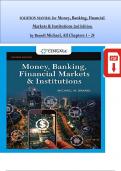SOLUTION MANUAL for Money, Banking, Financial
Markets & Institutions 2nd Edition
by Brandl Michael, All Chapters 1 - 24
,TABLE OF CONTENTS
Part I: MONEY AND ITS PRICES.
1. Introduction and Overview.
2. Money, Money Supply and Interest.
3. Bonds, Loanable Funds & Interest Rates.
4. Interest Rates in More Detail.
Part II: MONEY AND OVERALL ECONOMY.
5. Financial Markets through Time.
6. Aggregate Supply & Aggregate Demand.
7. Banks and Money.
Part III: CENTRAL BANKS.
8. Central Banks.
9. Monetary Policy Tools.
10. The Money Supply Process.
11. Monetary Policy & Debates.
Part IV: THE BANKING SYSTEM.
12. Bank Management.
13. Bank Risk Management & Performance.
14. Banking Regulation.
Part V: FINANCIAL MARKETS.
15. Money Markets.
16. Bond Markets.
17. Stock Market & Efficiency.
18. Mortgage Market.
Part VI: GLOBAL FINANCIAL MARKETS.
19. FX.
20. Global Financial Architecture.
Part VII: FINANCIAL INSTITUTIONS.
21. Thrifts and Finance Companies.
22. Insurance and Pensions.
23. Mutual Funds.
24. Investment Banks and Private Equity.
, CHAPTER 2: Money, Money Supply, and Interest
2-1 Section Review
1. What is the difference between money and currency? When are they the same? Why might they be different?
ANS: Money is anything generally accepted in exchange for goods & services. Currency is issued by a bank or the
government, but currency is not necessarily money. They are the same when they are accepted in exchange for
goods and services. Currencies can stop being money if people don’t acceptthem in exchange for goods and
services. If a group of people stop using currency to get goods and services but instead use bananas, then the
bananas are the money.
2. How many prices must a barter economy have if the economy has four goods? What if it has 400goods?
Explain why having a money in the second case is beneficial.
ANS: 4 goods = 6 prices; 400 goods = 79,800 prices. Money allows us to specialize and reduce our search cost.
Money allows us to reduce the number of stated prices we need.
3. You read a news story about a country that is suffering from rapid, ongoing increases in the cost of living.
Which characteristic of money is being directly negatively impacted in that economy?
a. Unit of account
b. Medium of exchange
c. Store of value
d. Double coincidence of wants
ANS: C
2-2 Section Review
1. Bobby is confused. He states: “Since prisoners are not allowed to smoke in prisons any longer,
Radford’s examples of cigarettes in POW camps no longer applies.” How would you explain to Bobby how
Radford’s story demonstrates the concepts of the criteria of money, as well as the importance of changes in the
money supply?
ANS: Any asset that is able to be standardized, divisible, durable and in demand could be currency, as long as it is a
medium of exchange, is a unit of account and has store of value. Cigarettes were money.
, 2. Proponents of the Gold Standard, or using gold as money, often argue that it will keep inflation under control.
How does the experience of Europe in the sixteenth century raise doubts about that claim?
ANS: If people start to hoard gold or silver, there may not be enough money, and an economy could slide into
recession. If gold or silver increases too rapidly the economy could suffer inflation.
3. Ricardo and Friedman agree that if the money supply increases “too quickly” the following happens:
a. The rate of inflation decreases.
b. The rate of real economic growth increases.
c. The rate of inflation increases.
d. The level of employment decreases.
ANS: C
2-3 Section Review
1. A critic of money economics once stated, “if you cannot measure the money supply accurately, it isnot worth
discussing at all.” How would you refute this statement?
ANS: Due to changes in financial markets, financial innovation and changes in the way banks operate, led to the
decline in the usefulness of M2 as a monetary aggregate.
2. Economists are searching for a “good” measurement of the money supply. What constitutes a good measurement
of the money supply?
ANS: To economists, a “good” measurement of the money supply is one that conforms to economic theories
regarding inflation and the economy. For example, if the money supply (according to a particular measurement)
increases faster than the growth rate of the economy, then economic theory suggests that inflation should occur. On
the other hand, if the money supply (according to a particular measurement) increases too slowly relative to the
growth rate of the economy, then economic theory suggests that this will result in a recession. When the
measurement of the money supply coincides withthese economic predictions, then that particular measurement has
the potential to be a “good” measurement of the money supply. During certain periods of time, both M1 and M2
have been
considered to be “good” measurements of the money supply. However, there have also been periods oftime where
the changes in M1 or M2 did not coincide with economic theory.
3. Which of the following is the broadest or most inclusive measurement of the money supply?
a. M1
b. M2
c. M3
d. M0
ANS: B





